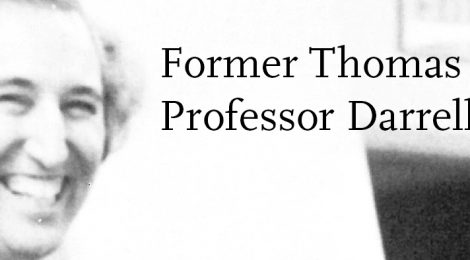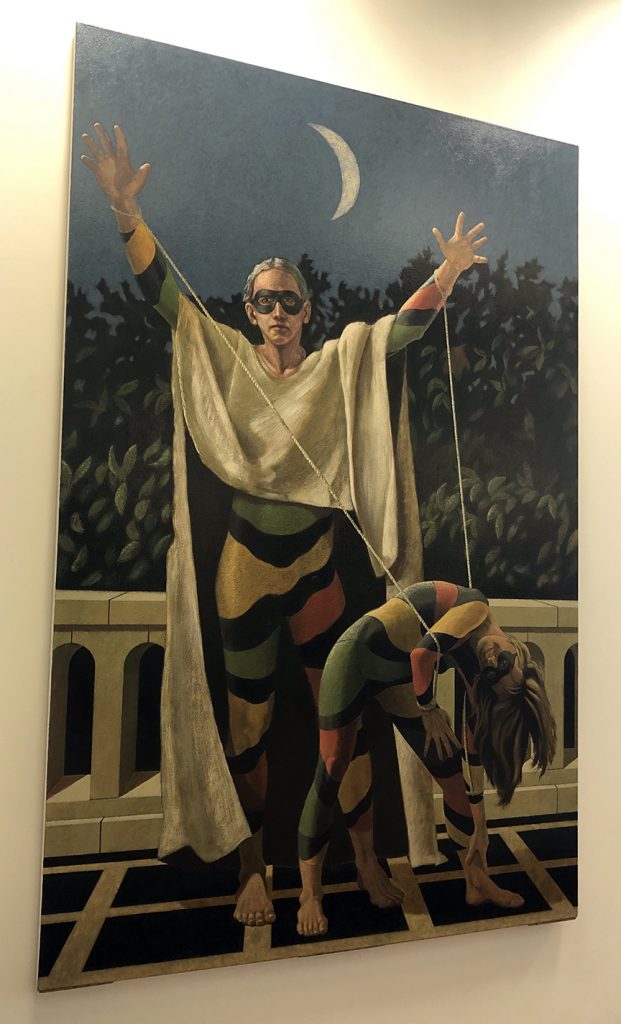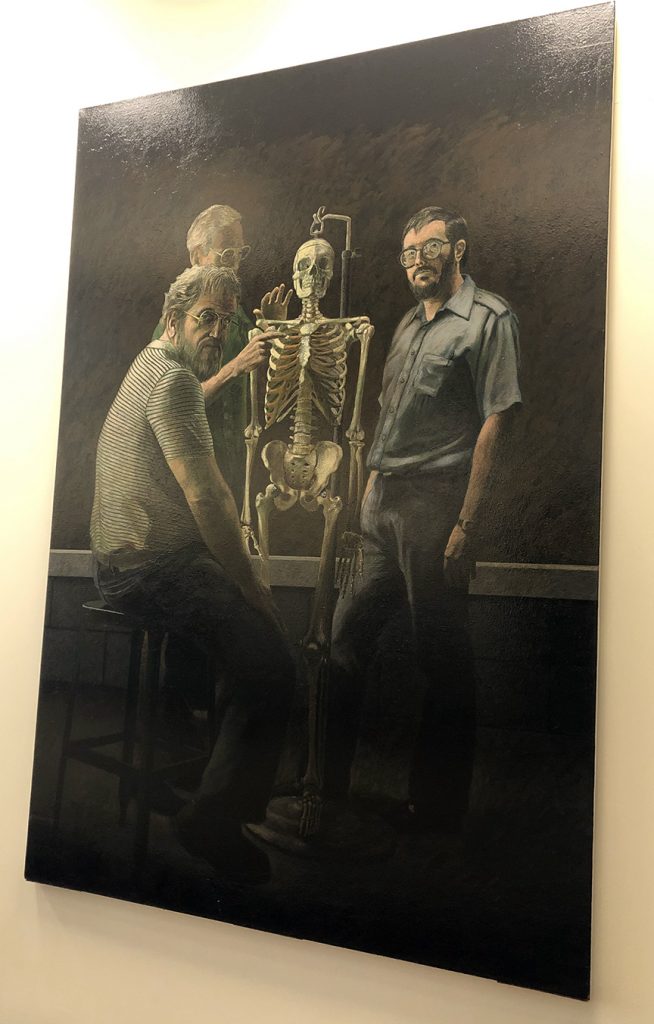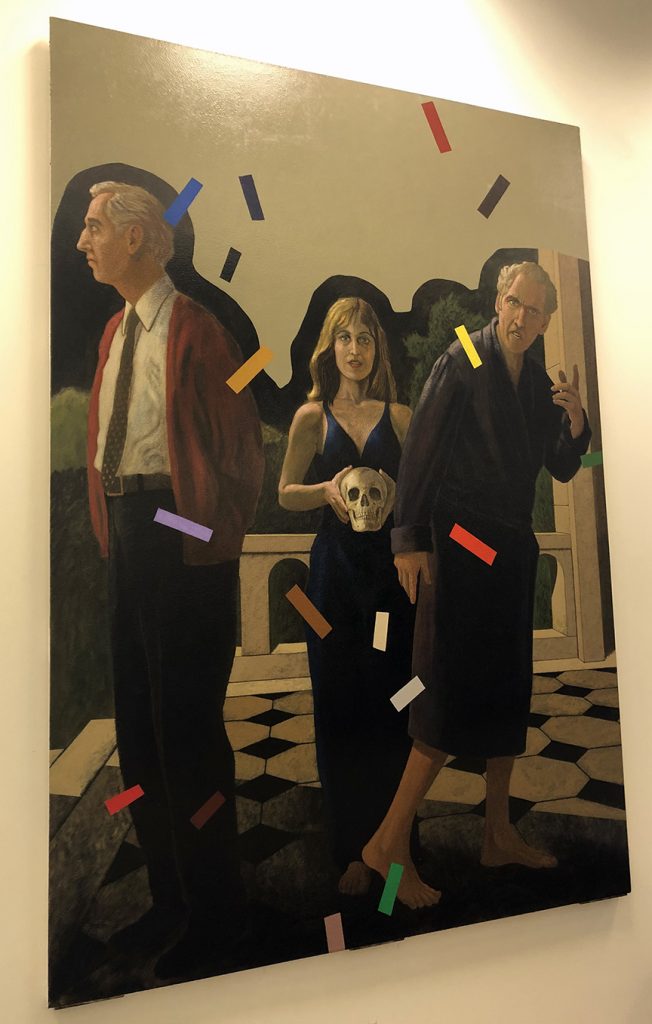
Reinstalling The Darrell Brothers Collection
Reprinted from spring 2005 Moreover with updates – by Rebecca Wright Bilbo, Ph.D.
In the fall of 1993, Thomas More acquired a collection of paintings from the estate of the late Darrell Brothers, a former professor and chairperson of the Art Department (1970’s-1990’s). As the succeeding chair of the department, I was invited by Darrell’s wife, Betty Brothers, to select the paintings she and Darrell would so generously donate to Thomas More.
Although many of the art students from Thomas More had been in Darrell’s studio during painting class, I myself had never taken the opportunity to visit, so his work was totally new to me. I was amazed at the sheer size in which he worked. No wonder none of his paintings graced the walls of the art studios. The ceilings and the spaces are far too small to accommodate any of them. My mind went blank as to where we could hang these works for all to see.
The painting “Harlequins Five”* was easy to place and found a home in the entrance atrium in the Administration Building. The vertical “Artists’ Study,”* resided for a short time in Seiler Commons, but for security reasons was hung far too high for proper viewing. This and the other two large paintings were then installed on the second floor of the library, the only other space on campus that could accommodate their large vertical format. There they hung, obstructed by rows of bookshelves for more than ten years.
With the renovation of the first and third floors of the library (summer 2004), we had the chance to find a more suitable home for these works. We scoured the campus for a new location and discovered the Student Center was not only large enough but needed artwork to adorn the halls of the expansive and brightly lit atrium. So with the help of our facilities department, the Darrell Brothers Collection was successfully reinstalled into its new permanent home.
During his time at Thomas More, Darrell rarely spoke in specifics about the meaning of his work. In fact, he never issued titles to any of his paintings. As is often the case with unnamed canvases, those who write about them offer what they believe are suitable titles to help identify the pieces for discussion. I have taken that liberty for this article and for my art history students who use these works for study.

Although we never spoke specifically about these works, Darrell and I discussed at length his thoughts about the nature of art and how it should be taught. He had a great fascination with the Italian Renaissance development of rules for perspective. He studied it assiduously, creating a special box for viewing and drawing accurate perspective. This aspect of his art is apparent in the work I refer to as “Tribute to Piera della Francesca.” This work hangs on the northwest wall of the atrium, near the entry doors to Steigerwald Hall in the Saints Center. In this painting, the grid-like floor pattern defines the space in a quest to create accurate and believable interiors, much like Piero della Grancesca and other early Renaissance masters would have painted.

Darrell found that his greatest contribution to art was in teaching. Like the American artist and teacher of the Pennsylvania Academy of Art, Thomas Eakins, he believed that the greatest subject of art was the human figure. His own studies of the figure brought him into the anatomy labs with University of Cincinnati medical students. Every student of figure drawing begins his study with the human skeleton. Here in the Brothers’ painting (in the southeast corner of the atrium), which I call “Artists’ Study” we see Darrell himself along with a student and colleague as they examine a human skeleton for drawing. To emphasize the importance of the skeleton, He made it the center and focal point of the composition.

The third and last painting currently hanging in the atrium, “The Vanitie,” introduces modernism to a classic but dreamy composition. This classical-modernism dichotomy expresses the conflict between the abstract qualities of the New York School in the 1940’s and 1950’s (when Darrell first entered the art world) and the traditional classical teaching in American art schools. The push-pull theories of Hans Hoffman intersect with Darrell himself, wrapped in his bathrobes he hurries across the picture. The symbol of mortality, or moments more, familiar to all art students, awaits at the bottom of the canvas.
These paintings are a proud reminder of a dedicated teacher and painter and of the important role that the fine arts and humanities play in the history and curriculum of Thomas More.
*The titles included here are those given by Rebecca Bilbo for purposes of discussion and not the titles given by the artist.
To hear interviews with Monsignor William Cleves and Dan Mader ’71, Ph.D., regarding these pieces of art as part of the Art@ThomasMore series, CLICK HERE.

Comments are closed, but trackbacks and pingbacks are open.